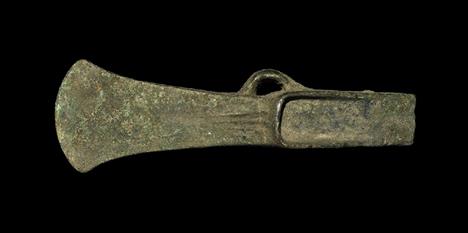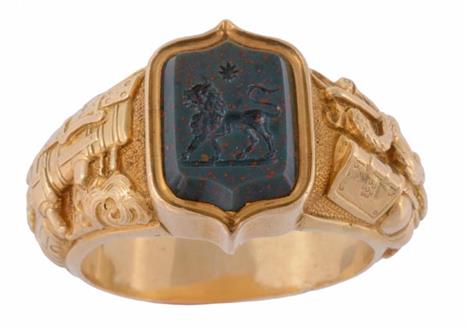Stone Age British Knapped Axe HeadLate Mesolithic, 8000-5000 BC. An early small axe with slightly convex cutting edge; in a graduated grey-black flint with slight traces of polish to high points. Cf. Smith, Reginald M. The Sturge Collection, no.169. 88 grams, 90mm (3 1/2"). Property of a gentleman, by descent from the vendor`s father, who formed his collection in the 1990s; found Suffolk, UK, in 1972. [No Reserve]Very fine condition. Rare type.
14782 Preisdatenbank Los(e) gefunden, die Ihrer Suche entsprechen
14782 Lose gefunden, die zu Ihrer Suche passen. Abonnieren Sie die Preisdatenbank, um sofortigen Zugriff auf alle Dienstleistungen der Preisdatenbank zu haben.
Preisdatenbank abonnieren- Liste
- Galerie
-
14782 Los(e)/Seite
Stone Age Danish Polished Stone Axe HeadNeolithic, 4000-2000 BC. A finely made axe head of deliberately asymmetric and early form with one side tapering from the convex cutting edge to the square butt; knapped sides and butt end and with cutting edge polished; in a mottled brown flint with some evidence of usage wear to the edge and surfaces. 484 grams, 11cm (4 1/4"). Property of an Essex collector; acquired London, UK, 1970s; found Jutland region, Denmark, before 1950. Very fine condition.
Bronze Age Bronze Axe Head1200-800 BC. A cast palstave axe head with flared vertical blade, short horizontal blade and central socket. Cf. Evans, J. The Ancient Bronze Implements, Weapons and Ornaments of Great Britain and Ireland, London, 1881, fig.85. 160 grams, 95mm (3 3/4"). From an important London collection, acquired in the 1970s. Very fine condition.
Bronze Age British Palstave Axe Head2nd millennium BC. A broad flared blade with chamfered edge, thick shank with deep recess and raised median rib to each face. Cf. Evans, J. The Ancient Bronze Implements, Weapons and Ornaments of Great Britain and Ireland, London, 1881, item 64. 469 grams, 16.5cm (6 1/2"). From an old Hampshire collection. [No Reserve]Very fine condition.
Bronze Age Socketted Axe Head1000-500 BC. A cast looped and socketted axe head with flared cutting edge, collar to mouth and raised circumferential rib. Cf. Evans, J. The Ancient Bronze Implements, Weapons and Ornaments of Great Britain and Ireland, London, 1881, figs.116, 120. 191 grams, 91mm (3 1/2"). Found near Bury St Edmunds, Suffolk, UK, 2014. [No Reserve]Fine condition.
Post Medieval Bronze Charles I Beheaded Commemorative PendantAfter 1649 AD. A cast bronze discoid pendant incised with a decapitation scene comprising a small figure to the left brandishing a large axe, the body of Charles I to the right with extended arm, the bearded head placed centrally with radiating lines representing gouts of blood; above the word REX in seriffed capitals and below the word MORT. 9.80 grams, 37mm (1 1/2"). Property of a Northumbrian professor; formerly in an important West Country collection. Fine condition. Rare.
Near Eastern Babylonian Duck-Billed Axe Head2nd Millennium BC. A cast axe head with ovoid socket and ribbed tongue-shaped blade, two elliptical piercings to each face extending to the socket. 163 grams, 11cm (4 1/4"). From an important London collection, acquired in the 1970s. Fine condition.
Viking Iron Bearded Axe Head9th-11th century AD. A hand-forged iron skeggöx (bearded axe) with asymmetrical blade, flared wings to the socket and dorsal bar. Cf. Sedov, B.B. Finno-Ugri i Balti v Epokhi Srednevekovija, Moscow, 1987, table V, items 16, 17. 237 grams, 11cm (4 1/4"). Property of an American collector; acquired 1980-2000. [No Reserve]Fine condition.
Near Eastern Luristan Bronze Sar-e Tabor Axe Head2200 BC. A Bronze Age axe head with socket with ribbed upper edge and ribbed chevrons to the rear face; the blade triangular in plan with convex edge and swept profile. Cf. Khorasani, M.M. Arms and Armour from Iran - The Bronze Age to the End of the Qajar Period, Tuebingen, 2006, p.659, Cat.344. 153 grams, 10.5cm (4"). From an old English collection; acquired in the 1980s. [No Reserve]Fine uncleaned `as found` condition.
Near Eastern Luristan Bronze Sar-e Tabor Axe Head with Decoration1250-650 BC. A Bronze Age axe head comprising a long tubular socket with incised ropework detail, long straight blade. Cf. Khorasani, M.M. Arms and Armour from Iran - The Bronze Age to the End of the Qajar Period, Tuebingen, 2006, p.659, Cat.343. 344 grams, 12.5cm (5"). From an old English collection; acquired in the 1980s. [No Reserve]Fine uncleaned `as found` condition. Rarely found decorated.
Near Eastern Luristan Bronze Sar-e Tabor Axe Head1250-650 BC. A Bronze Age axe head comprising a tubular socket with thick flange rim above, ovoid upper face and curved blade. Cf. Khorasani, M.M. Arms and Armour from Iran - The Bronze Age to the End of the Qajar Period, Tuebingen, 2006, p.659, Cat.344. 185 grams, 76mm (3"). From an old English collection; acquired in the 1980s. [No Reserve]Fine uncleaned `as found` condition.
Near Eastern Luristan Bronze Sar-e Tabor Axe Head1250-600 BC. A long Bronze Age axe head with ribbed socket; the blade straight in plan with flat edge and swept profile. See Khorasani, M.M. Arms and Armour from Iran - The Bronze Age to the End of the Qajar Period, Tuebingen, 2006. 210 grams, 13cm (5 1/4"). From an old English collection; acquired in the 1980s. [No Reserve]Fine uncleaned `as found` condition. Scarce type.
Greek Aegean Bronze Chisel2nd-1st millennium BC. A substantial cast chisel or flat-axe with slightly flared blade, rectangular-section body and splayed butt; mounted on a custom-made stand. Cf. Branigan, K. Aegean Metalwork of the Early and Middle Bronze Age, Oxford, 1974, item 600. 659 grams, 16cm (6 1/4"). Property of a West London gentleman; acquired between 1980-2010. [No Reserve]Extremely fine condition.
Two Continental silver statues, study of an Aztec warrior, bearing axe and torch, dressed in ceremonial robes and headdress, standing on a plinth with leaf and foliate decoration, set on scroll feet, 18.5 H and a statue of a girl holding a floral garland, standing on an orb over leaf decorated finial, pierced leaf stepped base, paw feet, 18.7cm H.
A 19th Century Zulu spear, with wide steel double-bladed spearhead, with banded decoration on hardwood stem, the terminal with flat axe-head type tip and conforming decoration, 72in. (183cms) long; together with a throwing spear, with steel head and tapering wooden stem, 61in. (155cms). (2)
VILLAGE POSTMARKS (A&B) album containing 72 covers & 130 stamps or stamps on piece all with village/town postmarks, mainly letters beginning with A&B, QEII period and a few KGVI incl. Abonkoe, Albany, Airy Castle, Albion, Alexandria, Alley, Allman Town, Anchory, Annotto Bay, Arawak, Axe & Adze, Balaclava, Bamboo, Banbury, Bangor Ridge, Barking Lodge, Bath Mountain, Baule, Beckford Kraal, Beeston Spring, Bellas Gate, Benbow etc. Symbol: MD
A pair of late George III silver wine coolers and collars by John & Thomas Settle, Sheffield 1817, embossed overall with bold foliate scrolls and rocaille work, on pedestal bases, the collars numbered 1 and 2, the liners of old Sheffield plate, the coolers and collars engraved with two crests, engraved beneath Virginia Winn from Webb- July 10th 1945, 26cm (10 1/4in) high, the coolers and collars 4079g (131.2 oz). Engraved with the crest of a griffin`s head from a mural coronet recorded for AMOND, BASQUER, BISHOP, ESSEX, GILBERT, LOCKSMITH, MOSS, REAY, STOCKDALE, THOMLINSON, UMFREVILLE, WESTCOMBE and WHEELER accompanied by a demi-lion holding a Lochaber axe possibly for MURRAY. Provenance: The wine coolers were a 35th anniversary gift from William Webb Wheeler, Jr. to his wife, Virginia (nee Burnes), and are by direct descent to the current vendors. The first Wheeler who appears on the family tree is Levi, born in 1796, next is David (1823-1861), followed by William Webb Sr., then William Webb Wheeler Jr., William Webb Wheeler III and William Webb Wheeler IV. William Webb Wheeler, Junior`s father owned the mercantile business which Jr. inherited and ran through the crash of 1929, and was renowned for building up an important library. Virginia Winn (Wynne) Burnes Wheeler was the daughter of Lewis Calvin Burnes, president of the Burnes National Bank and was a member of the Daughters of the American Revolution (DAR). The original immigrant to America in 1771 changed his name from Peter Burness to Burnes.
A 19th century French gold and bloodstone signet ring, circa 1890, the shaped bloodstone cartouche engraved with a lion below a star, the shoulders with chased and moulded decoration in the form of a train to one side with various luggage and a pick axe, the other side with a caduceus, parcels and a book, the shank stamped with French poincon, and a further rubbed mark. The crest is possibly for the French family, Dubois. In 1890, the explorer Albert Felix Dubois (1862 - 1945) established the route of a railway line from the Mellacoree River to Kankan in the French colony of Guinea
A pair of Sitzendorf candelabra one depicting a musician playing a recorder to a female seated upon a goat, the second depicting a man with axe in hand, seated upon a sled, both with three candle deposits on upwardly curved branches with applied floral and foliate decoration, 11½in. (29.3cm) high. (2)
A 17TH CENTURY OAK COURT CUPBOARD having a frieze carved with strap-work motifs and centred initials WTE with date 1695, central arched panel, panelled cupboard doors and turned barley twist supports, the lower stage having a large triple panelled door with iron axe-form hinges, all between incised rails, muntings and stile ends, the latter extending as feet. 152cm(h) x 135cm(w) x 53cm(d)CONDITION: replacement hinges to upper doors, replacement shelf to lower interior, loose base boards, otherwise in age appropriate condition.
Two Continental silver statues, study of an Aztec warrior, bearing axe and torch, dressed in ceremonial robes and headdress, standing on a plinth with leaf and foliate decoration, set on scroll feet, 18.5 H and a statue of a girl holding a floral garland, standing on an orb over leaf decorated finial, pierced leaf stepped base, paw feet, 18.7cm H.
A Meissen figure group of Winter late 18th/early 19th century, personified as a boy seated on a sled and wearing a fur-trimmed hat and cloak, an axe on one knee and a bundle of faggots by his side, his companion warming her hands over a brazier, blue crossed swords and star mark, later decorated, some restoration, 14cm.
A Meissen figure group of Winter late 18th/early 19th century, personified as a boy seated on a sled and wearing a fur-trimmed hat and cloak, an axe on one knee and a bundle of faggots by his side, his companion warming her hands over a brazier, blue crossed swords and star mark, later decorated, some restoration, 14cm.
A collection of Britains soldiers contained in a 1920?s ?Types of The British Army? large display box. Including 7 mounted Lifeguards, 6 17th Lancers including Officer. Royal Field Artillery set, complete with a six horse team and mounted Officer. 11 Welch Fusiliers including Officer and Farrier with axe, plus ram mascot. 12 Seaforth Highlanders. 14 Infantry band. An Officer of the General Staff, with binoculars. 7 Royal Scots Greys. Pieces from the Mountain Gun of the Royal Artillery ? 7 soldiers and 4 mules, gun pieces missing. 14 various soldiers in khaki including examples in gas masks. Together with a few other unrelated pieces including WW1 machine gunners and North American Indians. Contents mainly in GC-VGC a few with parts AF and with minor/some chipping. Box age worn overall. See inside front cover.
-
14782 Los(e)/Seite















































